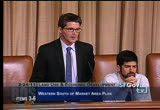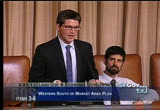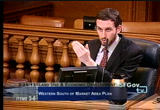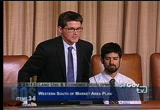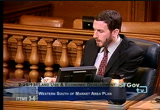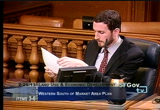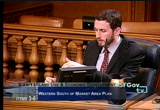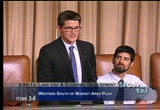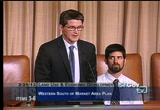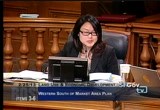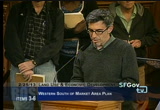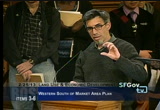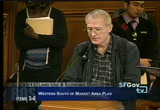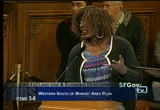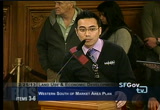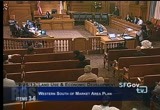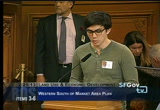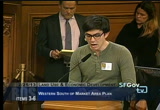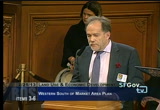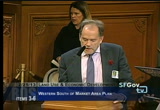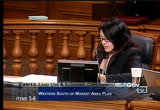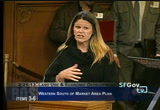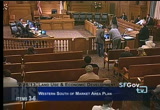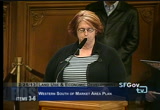tv [untitled] February 26, 2013 8:00am-8:30am PST
8:00 am
works. obviously jim niko and others are here to provide more intent about the treatment of those sites in the process. the general idea is essentially those are large sites that can accommodate potentially a larger amount of growth. where having an additional floor may be valuable enough to, if you create an incentive like this, have this trade-off happen. as was mentioned affordable housing is a very important goal as are many goals in the plan, but affordable housing is incredibly important and these provide an opportunity to provide more affordable housing. not in a way that would not work and essentially make projects not pencil out that. is why the trade-off was given. the model for that is something that is already happening at eastern neighborhoods which is the umu district. all of the parts are that zoned
8:01 am
umu have a residential impact fee tier of one, which is the lowest, regardless of how much zoning the property received. instead the paying the city a standard rate for affordable housing or providing it, they are required to provide affordable housing on a higher tier based on the upzoning. so it basically works out to be same trade-off. >> and by the way, i completely agree with you, and with supervisor kim's comments in the beginning about how critical affordable housing is. and for that reason, not only did i vote to put prop c on the ballot, i was a cosponsor and actively campaigned for it, which will generate close to $1.5 billion for affordable housing. if you talk to affordable housing developers, they will talk about how i harassed them to put affordable housing in the area because we decent have enough there. i understand and agree with the critical need for affordable
8:02 am
housing. and so typically when we add new residential density, for example, going up to a larger concentration of residents say in these larger projects. that does place additional strain on our transit system. is that the case? in our planning code, that is how we typically view increases in density requiring additional transit investment; right? >> yes. >> okay. and and so here what happens is when you go above a certain size, in the affordable housing fees go up to the higher tier. transit and open space impact fees actually as well go down. and that become more or less somewhat of a wash for the developer in terms of the
8:03 am
overall level of impact fees, is that right? >> that is not entirely accurate. it is accurate in the sense it's a 33% reduction in residential impact fees and a 33% increase in affordable housing. but the actual cost of providing the affordable housing is generally understood to be more than the reduction in fee. >> so the overall impact fee level goes up, but not by as much as if you just increased one fee, right? so if you just increased the affordable housing fee period, that would be significantly higher increase than what we have here? because we're lowering the transit impact fee, open space impact fees, et cetera? >> so the scenario that you are describing, if i understand, that there is no -- there is no trade-off. it's just requiring more affordable housing without any reduction in anything else? >> correct. >> okay.
8:04 am
and you are asking would that be more to a development? >> right now, if we had simply said we value affordable housing. so we want to increase affordable housing fees, period. and we're just going to do that and not reduce any of the other impact fees, that would be a pretty significant increase in terms of overall impact fees for the developer, correct? >> yes, it would be an increase. obviously, the amount of increase of affordable housing required would come into play in terms of how much of an increase it would be? >> right. so in order to avoid that much of an increase, we're reducing these other impact fees, which include transit impact fees? >> yes, that is the idea. >> okay. now in terms of just understanding the amounts that we're talking about. i think that is very important. my understanding is that there are 13 sites in the plan area
8:05 am
that would qualify for this potential increase in size to the point it would trigger the reduction in transit and other impact fees? >> so there are only 18 properties that are actually zoned for this split height. but of those 18, five are definitely not going to be developed. depending on how you define a self-site, the maximum would be 13 properties available to take advantage of that. >> and we actually asked you for an example of the actual numbers and you provided us with 900 folsom street as one of the examples. and the numbers that we see here in terms of the transit and public realm improvements, for example pedestrian safety.
8:06 am
it would reduce from 1.25 million to $836,000 for a change of approximately $417,000? >> that is correct. the example we provide sade d is a development that is approved and under construction. it was a good project to use as an example and pull the numbers from. those are the numbers that would be generated. >> so that is almost slightly less than $500,000 reduction in transit impact fees. if you extrapolate that out, times it by 13 and obviously different projects range in size. some might be larger than that, some might be smaller. i calculate that as being
8:07 am
approximately a reduction of $6 million in transit, ped safety impact fees and it's actually an overall reduction of $13 million, including open space impact fees as well. about $6 million of that would come from transit and transit-related impact fees. >> the only thing i'm not sure about there is we would have to look at the development potential site. obviously the numbers used for 900 folsom is a large site , but we could do a more elaborate analysis of those sites within western soma for
8:08 am
information next week. but for this week, such an analysis wasn't quite possible. but based on those numbers, if you project that out, using 900 folsom as an example, those numbers sound accurate. again, if we converted those to the sites available in western soma, i think we would get a different number. >> maybe it's not $6 million, but $3 million or $4 million, but still in the millions. >> i'm sorry? >> i said whether it's $6 million or cut it about a third, $4 million or even in half, $3 million, i would imagine it's in the millions. >> potentially. it also depends if we're looking at a full-capacity. you know, if every project built to its full capacity, what would those numbers be or what are we projecting to
8:09 am
develop over the next 25 years, which is generally when we do and make it a more complicated analysis. >> it's a 33% reduction in fees related to transit and transit-related fees, correct? >> that percentage would be maintained on each project. >> okay. and where would we get the money to improve transit to accommodate all of these new residents who resumably are going to be relying on, it since we don't want them to own cars? >> as you mentioned earlier, we do have the transit impact development fees, which goes directly to transit and funded by non-residential development. >> so residential development doesn't pay that? >> right now that does not happen. in one of the slides that we looked at, one the three
8:10 am
buckets, the open space, streetscape and public grounds, our projection is that the bucket would receive more than the others. and within that 42% residential bucket, those are a variety of improvements and many of the priority projects that are listed within western soma, related to transit streetscape are very much streetscape-related and not primarily for transit. so there is no question there is a conscious trade-off for public realm improvements, but that was a policy decision that they came to. >> right. and i'm not trying to -- this was obviously not your decision. it was a group decision.
8:11 am
and i will stress that right now as you noted the transit impact development fee does not cover housing at all. and when the transit sustainability project and fee, a discussion that we're having right now, i don't know what your confidence level that we'll see significant changes from the tdif. and we'll see what happens. but i wouldn't hang my hat on that. so great. those are my questions. supervisor kim. >> thank you. i was just going say that i know we'll have a robust discussion after public comment, but i wanted to note that some of our folks have been waiting for two hours to speak. so i wanted to get quickly to those as possible, but president chiu. >> just to add quickly to the discussion.
8:12 am
i was sitting in the capital planning meeting that the estimates of transit needs, and i would love to see for next week's meeting what type of trade-offs that we're looking at? and what the benefits or successes have been of what we have already done in the umu district? because i think and agree, these are both very important needs. we also appreciate the need for affordable housing and building housing without investment for transit would lead to longer term problems and i would echo the desire to see that and have additional conversations about that by next week's hearing. >> thank you. so if there are no further questions at this time, i did want to start calling up members of the public to speak. i do have a little over 40 cards at this point. so if you have not filled out a card, please do so. otherwise you can speak after
8:13 am
we have called everyone up. i will call the first ten names and feel free to line up on that side of the chamber. [ reading speakers' names ] >> thank you supervisor, it's great to see you here after eight years of working on this. my name is fernando marty and i'm representing the council of community housing organizations. i am also the district 6 representative in the eastern neighborhoods cac. and i worked at asian neighborhood design while this plan was under process. we have been here before, where we encounter a tendency to pit affordable housing and public transit as though it was a zero-sum game and something that is very interesting about the plan, that it presents
8:14 am
itself as building a complete neighborhood. creating a balanced between the many needs. over those eight years people came, argued, discussed, created compromises and came to conclusions about how to best serve the many needs to make those complete neighborhoods. we talk about the impact fees that exist, the housing fees, transportation fees, which are by the way, one of the largest pieces there, $22 million for public transportation will be created through this plan. and the many other needs that are needed, parks library, child-care. one of the things and perhaps corey teague, i know he is back there discussing, might be able to correct me. any understanding that the discussion where some fees go down by 33% and others go up does not affect the base line of any project that gets built. any project that gets built to permanent amount still pays what it would otherwise. the compromise that was reached
8:15 am
and the compromise that eastern neighborhoods reached was how communities being impacted by luxury development, except increased growth and way people look at how do we create stability? how do we fight gentrification? we need to create more affordable housing out of that increased growth. and the decisions that were made through this tiered zoning was to allow developers the choice of increasing heights in exchange for providing more affordable housing. this is a plan for stability for neighborhoods facing large scale gentrification, discussed over many, many years. >> thank you, mr. marty. >> good afternoon, supervisors, my name is john
8:16 am
nulty. the committee approved the plan because of it going through a community process, adopt it is in its entirety, without amendments. i have been authorized to do so on believe behalf of the following organizations, foundation of san francisco, alliance for district 6 and city democratics. thank you very much. &thank you, mr. nulty. >> good afternoon supervisors. i was one of the original members of western soma task force when it was formed in 2004 and i'm going focus -- we have been talking about the red, and the red residential enclave districts, and in western soma, the buffering came in to not restrict, but to
8:17 am
level the noise level within that area. those areas had not been addressed this thorough before, even before the pullout from eastern neighborhoods. on the eastside of soma, this was to ensure that those there was more safety focused around reds and the alley ways that have very narrow and some alleys are wider than others. and affordable housing that you can afford though live in. i will wrap this up by saying western soma community planning is a moil for how the planning department can work in
8:18 am
partnership with real stakeholders to drill-down and craft thoughtful, balanced and comprehensive community plan as the city continues to grow and face difficult planning decisions. it's a reminder of what we can accomplish together. >> thank you and thank you for your service on the task force. x hi, my name is daniel winn and i'm a property manager. that is one of the reasons that i want this plan to go through is our neighborhood really needs the improvement. one of the biggest things is the alleyways between natoma.
8:19 am
it's just really time that we need to refocus on this area. when there are more and more people coming in. i can guarantee you more and more people are moving from out-of-state into the city, because i rent to them all day. and they increase the rent revenue in this part of the area by 18% compared to 2008. and on top of that, there are tons of issues that they bring up, when they do move here. i want to commend supervisor kim's office for really being in the community and going to community meetings and learning about this. i do have some photos if anyone wants to look at them about all the crime that happens back there. i just wanted to say i want this to move forward and anything that we can do to help, we would love to help. we do provide affordable housing in our community as well and any new development we're building i'm pretty sure is going to have some sort of fractionable affordable housing as well. thank you.
8:20 am
>> thank you. >> hi my name is ken hornby. i just wanted to say every since they put the pause in between mina and natoma, we have had nothing, but problems, homeless encampments, drug use, needles, defecation and it all happens right in front of a playground. >> mr. honda, i want to clarify our office will continue helping in safety of this area. it's not included in this west soma plan. so please do just speak to the plan. thank you. >> all right. >> we're here in support of the western soma plan. many of our clients live or work in those alleyways and we
8:21 am
want to prioritize residential development, specifically affordable housing and really urge the committee to support plans and projects that invest in the current communities and invest in our residents and small businesses that serve the existing needs of our community. thank you. >> thank you, miss calderone. >> hi, my name is andrew naris. i wanted to thank the west soma task force and planning department for working on this plan. i know a lot of work went into it, but i want to talk briefly about slim's experience with residential neighbors. one neighborhood in particular was able to threaten our business, and performing
8:22 am
citizen arrests on these young night managers, who are to go to court on their own time facing charges, just doing their job. the charges were eventually dropped, but it was a huge disruption from their lives. the complaints from one particular neighborhood led to the california abc suspending slim's license. the next violation would be a 30-day closure and the next violation would be revocation, meaning the end of our business. i wanted to thank the task force and planning department for recognizing the existing uses on 11th street for zoning uses that are complimentary to that.
8:23 am
i did want to touch on the building at 340 11th street, the purple building. i would urge the commission to take a look at other uses for that building that would be more compatible were entertainment that is existing on the block. thank you. >> thank you. >> mr. chair, supervisor my name is mark reney, i have live merchandise west soma continually since 1974 and have co-own a number of businesses. you am currently a partner at restaurant at 2nd and folsom and i was develop involve in the 1990 rezoning and somewhat involved in this plan and although it was a herculean effort by mr. niko, toby and others, i have to somewhat dispute the contention it was all balanced, fair and inclusive. i went to a number of meetings
8:24 am
at betsy carmichael school and as a nightlife supporter, i think i'm in favor of the plan with some amendments. but i think san francisco needs vibrant nightlife. tourism for better or worse is our no. 1 industry and tourists need something to do after dark. we need the tax revenue and we need places for our youth to go and what is more logical than downtown and west soma, next to regional transit, next to the san francisco tourist hubs and tourist hotels? i understand some of these are going into trailing legislation, but i would like to speak for a second on uses of the second floor for restaurant and lounge uses in west soma and if if this is approved, if you look
8:25 am
at chinatown and other neighborhoods, castro district, this has worked well. and it hasn't caused a problem from the neighborhoods. the people will have to go to conditional use on this and be part of extensive neighborhood outreach and discussion. but i would ask this board to approve that second floor usage as this would expand the opportunities to enliven west soma and bring it back to the great tourist destination that i remember in the '80s. >> thank you, i remember that west soma is the birthplace for love and thank you for that comment. [ laughter ] >> i will call up ten more speakers before our last speaker of this pile. [ reading speakers' names ]
8:26 am
>> my name is karen nolan and i was one of the original members of the task force, but had to resign after the first year. i am here today to support the plan. i do have concerns when i hear talks of plans for nightlife. i am not against nightlife, but i live next door to the 1015 club and i know that the problems that we had over the years in trying to mitigate those problems, i think what mr. reney just spoke of, maybe second-floor lounge, jazz trios, something like this. but the nightclub scene of it's not neighborhood-serving. i know it brings in tax revenue, which is great for the city, but i would like to see folsom street more of a neighborhood-serving retail,
8:27 am
and shopping. the nightclubs are dead during the day and their only open friday, saturday, sunday sometimes thursday. i just don't see that as a good use on a busy commercial corridor. the second-floor idea, that is great. thank you. >> thank you miss nolan and thank you for your service on the task force as well. >> we have a video that we would like to plug in? is that possible, mr. teague? >> sfgovtv, is that possible? maybe we can allow another speaker to go while that is happening. >> miss holiday. [ inaudible ] i also want to bring up 340 11th street and
8:28 am
the reasons i would be opposed to the grand father status. this was when we were closed down by the abc, after working with our neighbor. we did try mediation and agreed to certain terms of mediation, which we exceeded and it didn't work out. we tried every possible step that properly would address her concerns and concerns of the other neighbors that she was working with. they stepped out. they were happy with results. it ended up with a $750,000 lawsuit. we broke no city ordinance. the city backed us up, the police department backs backed us and the closure impacted our staff, our business.
8:29 am
i believe that in good faith i would have a very hard time seming any kind of condition that was put on a building that wasn't stamped. because of the experiences that we had. i think the work that has been done, emotionally, and timewise, i completely support them. but i have 90 staff members and a business. thank you. >> thank you, miss holiday. >> good afternoon. i'm alphonz [speaker not understood] i came here primarily with some of my board members today to thank you, supervisor kim, for your support of our existence, through this plan. and also, mr. niko and his organization, we try to
64 Views
IN COLLECTIONS
SFGTV: San Francisco Government Television Television Archive
Television Archive  Television Archive News Search Service
Television Archive News Search Service 
Uploaded by TV Archive on

 Live Music Archive
Live Music Archive Librivox Free Audio
Librivox Free Audio Metropolitan Museum
Metropolitan Museum Cleveland Museum of Art
Cleveland Museum of Art Internet Arcade
Internet Arcade Console Living Room
Console Living Room Books to Borrow
Books to Borrow Open Library
Open Library TV News
TV News Understanding 9/11
Understanding 9/11